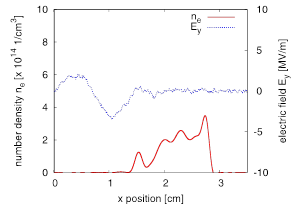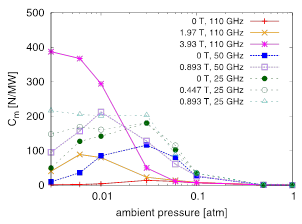Numerical Study of Breakdown and Shock Wave Structures for Improvement of Flight Performance in a Beamed-Energy Vehicle
JAXA Supercomputer System Annual Report April 2016-March 2017
Report Number: R16E0051
- Responsible Representative: Masayuki Takahashi(The University of Tokyo)
- Contact Information: Masayuki Takahashi(mtakahashi@rhd.mech.tohoku.ac.jp)
- Members: Masayuki Takahashi
- Subject Category: Space(Space transportation)
Abstract
Plasma simulations with kinetic particle and fluid models were coupled with an electromagnetic field propagation to reproduce the breakdown structure in a beamed-energy propulsion system. The compressible fluid simulation was also conducted to reproduce the shock wave propagation around the vehicle. Thrust performance and flight stability of the vehicle were improved by applying an external magnetic field into the breakdown region.
Goal
New technique is proposed to improve thrust and flight performances of a beamed-energy vehicle as the next generation space-transportation system. Beam-induced breakdown physics is also investigated to promote innovation of an aerospace technique using plasma.
Objective
Technical objectives to improve the thrust and flight performances, i.e. (1) proving plasma transition by an external magnetic field, (2) proving enhancement of the shock wave, and (3) proving control of the shock wave structure, are achieved by applying the external magnetic field into the breakdown region of a beamed-energy vehicle.
References and Links
N/A
Use of the Supercomputer
Using the supercomputer, coupling simulation between plasma reproduced by kinetic particle and fluid models and an electromagnetic field propagation was conducted to reproduce the breakdown structure induced by a beam irradiation. The compressible fluid simulation is also conducted to evaluate the thrust and flight stability of a beamed-energy vehicle.
Necessity of the Supercomputer
A large-scale parallel computing is required in the charged-particle simulation because number of the charged-particles becomes huge due to frequent electron-impact ionization. A computational cost also becomes huge in the simulation with a plasma fluid model because the multi-dimensional simulation with a large domain is conducted.
Achievements of the Year
Breakdown structure induced by an intense beam was reproduced by coupling a kinetic plasma model with an electromagnetic wave simulation (Fig. 1). Propagation speed of the plasma wassuppressed by applying an external magnetic field. An energy absorption rate was improved by satisfying an electron cyclotron resonance condition. The thrust performance was improved by combination between the plasma propagationsuppression and an increase in the energy absorption rate (Fig. 2).
Publications
Peer-reviewed articles
1) M. Takahashi and N. Ohnishi, 'Plasma Filamentation and Shock Wave Enhancement in Microwave Rockets by Combining Low-Frequency Microwaves with External Magnetic Field,' Journal of Applied Physics, Vol. 120, 063303 (2016).
2) M. Takahashi, 'Development of Plasma Fluid Model for a Microwave Rocketsupported by a Magnetic Field,' Journal of Physics: Conference Series (accepted).
3) M. Takahashi, 'Asymmetric Shock Wave Generation in a Microwave Rocket Using a Magnetic Field,' Journal of Physics: Conference Series (accepted).
4) M. Takahashi and N. Ohnishi, 'Open-front Approach of a Microwave Rocket Sustained by a Resonant Magnetic Field,' Journal of Propulsion and Power (under review).
5) M. Takahashi, Y. Kageyama, and N. Ohnishi, 'Joule-Heating-Supported Plasma Filamentation and Branching duringsubcritical Microwave Irradiation,' Applied Physics Letters (under review).
Non peer-reviewed articles
1) M. Takahashi, 'Gas-Species Dependency of Energy-Absorption Rate in Filamentary Plasma Induced by an Intense Microwave,' Proceedings of ISPlasma2017/IC-PLANTS2017 (2017).
2) K. Hamasaki, M. Takahashi, and N. Ohnishi 'Frequency Dependence of Filamentary-Plasma Structure in Microwave Breakdown in Air,' Proceedings of ISPlasma2017/IC-PLANTS2017 (2017).
Computational Information
- Parallelization Methods: Process Parallelization
- Process Parallelization Methods: MPI
- Thread Parallelization Methods: n/a
- Number of Processes: 100
- Number of Threads per Process: 1
- Number of Nodes Used: 10
- Elapsed Time per Case (Hours): 80
- Number of Cases: 20
Resources Used
Total Amount of Virtual Cost(Yen): 863,543
Breakdown List by Resources
| System Name | Amount of Core Time(core x hours) | Virtual Cost(Yen) |
|---|---|---|
| SORA-MA | 465,430.05 | 755,851 |
| SORA-PP | 0.00 | 0 |
| SORA-LM | 0.00 | 0 |
| SORA-TPP | 0.00 | 0 |
| File System Name | Storage assigned(GiB) | Virtual Cost(Yen) |
|---|---|---|
| /home | 476.84 | 4,210 |
| /data | 9,765.63 | 86,234 |
| /ltmp | 1,953.13 | 17,246 |
| Archiving System Name | Storage used(TiB) | Virtual Cost(Yen) |
|---|---|---|
| J-SPACE | 0.00 | 0 |
Note: Virtual Cost=amount of cost, using the unit price list of JAXA Facility Utilization program(2016)
JAXA Supercomputer System Annual Report April 2016-March 2017




